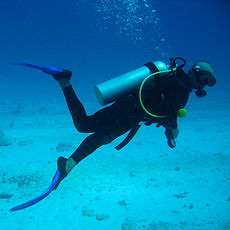Diving chamber
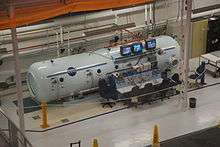 The decompression chamber at the Neutral Buoyancy Lab | |
| Acronym | DDC |
|---|---|
| Other names |
|
| Uses |
|
A diving chamber has two main functions:
- as a simpler form of submersible vessel to take divers underwater and to provide a temporary base and retrieval system in the depths;
- as a land or ship-based hyperbaric chamber to artificially reproduce the hyperbaric conditions under the sea (pressures above normal atmospheric pressure) for diving-related and non-diving medical applications such as hyperbaric medicine).
Basic types of diving chamber
There are two basic types of submersible diving chamber differentiated by the way in which the pressure in the diving chamber is produced and controlled.
Open diving bell
The historically older open diving chamber, known as an open diving bell or wet bell, is in effect a compartment with an open bottom which contains a gas space above a free water surface, which allows divers to breathe underwater. The compartment may be large enough to fully accommodate the divers above the water, or may be smaller, and just accommodate head and shoulders. Internal air pressure is at the pressure of the free water surface, and varies accordingly with depth. The breathing gas supply for the open bell may be self-contained, or more usually, supplied from the surface via flexible hose, which may be combined with other hoses and cables as a bell umbilical. An open bell may also contain a breathing gas distribution panel with divers' umbilicals to supply divers with breathing gas during excursions from the bell, and an on-board emergency gas supply in high pressure storage cylinders. This type of diving chamber can only be used underwater, as the internal gas pressure is directly proportional to the depth underwater, and raising or lowering the chamber is the only way to adjust the pressure.
Hyperbaric chamber
A sealable diving chamber, closed bell or dry bell is a pressure vessel with hatches large enough for people to enter and exit, and a compressed breathing gas supply to raise the internal air pressure. Such chambers provide a supply of oxygen for the user, and are usually called hyperbaric chambers whether used underwater or at the water surface or on land to produce underwater pressures. However, some use submersible chamber to refer to those used underwater and hyperbaric chamber for those used out of water. There are two related terms which reflect particular usages rather than technically different types:
- Decompression chamber, a hyperbaric chamber used by surface-supplied divers to make their surface decompression stops
- Recompression chamber, a hyperbaric chamber used to treat or prevent decompression sickness.
When used underwater there are two ways to prevent water flooding in when the submersible hyperbaric chamber's hatch is opened. The hatch could open into a moon pool chamber, and then its internal pressure must first be equalised to that of the moon pool chamber. More commonly the hatch opens into an underwater airlock, in which case the main chamber's pressure can stay constant, while it is the airlock pressure which shifts. This common design is called a lock-out chamber, and is used in submarines, submersibles, and underwater habitats as well as diving chambers.
Another arrangement utilises a dry airlock between a sealable hyperbaric compartment and an open diving bell compartment (so that effectively the whole structure is a mixture of the two types of diving chamber).
When used underwater all types of diving chamber are attached to a diving support vessel by a strong cable for raising and lowering and an umbilical cable delivering, at a minimum, compressed breathing gas, power, and communications, and all need weights attached or built in to overcome their buoyancy. The greatest depth reached using a cable-suspended chamber is about 1500 m; beyond this the cable becomes unmanageable.
Related equipment
In addition to the diving bell and hyperbaric chamber, related diving equipment includes the following.
- Underwater habitat: consists of compartments operating under the same principles as diving bells and diving chambers, but fixed to the sea floor for long-term use.
- Submersibles and submarines differ in being able to move under their own power. The interiors are usually maintained at surface pressure, but some examples include air locks and internal hyperbaric chambers.
- There is also other deep diving equipment which has atmospheric internal pressure, including:
- Bathysphere: name given to an experimental deep-sea diving chamber of the 1920s and 1930s.
- Benthoscope: a successor to the bathysphere built to go to greater depths.
- Bathyscaphe: a self-propelled submersible vessel able to adjust its own buoyancy for exploring extreme depths.
Underwater use
As well as transporting divers, a diving chamber carries tools and equipment, high pressure storage cylinders for emergency breathing gas supply, and communications and emergency equipment. It provides a temporary dry air environment during extended dives for rest, eating meals, carrying out tasks which can't be done underwater, and for emergencies. Diving chambers also act as an underwater base for surface supplied diving operations, with the divers' umbilicals (air supply, etc.) attached to the diving chamber rather than to the diving support vessel.
Diving bells
Diving bells and open diving chambers of the same principle were more common in the past owing to their simplicity, since they do not necessarily need to monitor, control and mechanically adjust the internal pressure. Secondly since internal air pressure and external water pressure on the bell wall are almost balanced, the chamber does not have to be as strong as a pressurised diving chamber (dry bell). The air inside an open bell is at the same pressure as the water at the air-water interface surface. This pressure is constant and the pressure difference on the bell shell can be higher than the external pressure to the extent of the height of the air space in the bell.
A wet diving bell or open diving chamber must be raised slowly to the surface with decompression stops appropriate to the dive profile so that the occupants can avoid decompression sickness. This may take hours, and so limits its use.
Submersible hyperbaric chambers
Submersible hyperbaric chambers known as closed bells or personnel transfer capsules can be brought to the surface without delay by maintaining the internal pressure and either decompressing the divers in the chamber on board the support vessel, or transferring them under pressure to a more spacious decompression chamber or to a saturation system, where they remain under pressure throughout the tour of duty, working shifts under approximately constant pressure, and are only decompressed once at the end. The ability to return to the surface without in-water decompression reduces the risk to the divers if the weather or compromised dynamic positioning forces the support vessel off station.
A diving chamber based on a pressure vessel is more expensive to construct since it has to withstand high pressure differentials. These may be bursting pressures as is the case for a dry bell used for saturation diving, where the internal pressure is matched to the water pressure at the working depth, or crushing pressures when the chamber is lowered into the sea and the internal pressure is less than ambient water pressure, such as may be used for submarine rescue.
Rescue bells are specialized diving chambers or submersibles able to retrieve divers or occupants of diving chambers or underwater habitats in an emergency and to keep them under the required pressure. They have airlocks for underwater entry or to form a watertight seal with hatches on the target structure to effect a dry transfer of personnel. Rescuing occupants of submarines or submersibles with internal air pressure of one atmosphere requires being able to withstand the huge pressure differential to effect a dry transfer, and has the advantage of not requiring decompression measures on returning to the surface, allowing a more rapid turnaround to continue the rescue effort.
Out of water use
Hyperbaric chambers are also used on land and above the water
- to take surface supplied divers who have been brought up from underwater through their remaining decompression as surface decompression either after an ambient pressure ascent or after transfer under pressure from a dry bell. (decompression chambers)
- to train divers to adapt to hyperbaric conditions and decompression routines and test their performance under pressure.
- to treat divers for decompression sickness (recompression chambers)
- to treat people using raised oxygen partial pressure in hyperbaric oxygen therapy for conditions unrelated to diving.[1]
- In saturation diving life support systems
- in scientific research requiring elevated gas pressures.
Hyperbaric chambers designed only for use out of water do not have to resist crushing forces, only bursting forces. Those for medical applications typically only operate up to two or three atmospheres absolute, while those for diving applications may go to six atmospheres or more.
Lightweight portable hyperbaric chambers which can be lifted by helicopter are used by military or commercial diving operators and rescue services to carry one or two divers requiring recompression treatment to a suitable facility.
Decompression chamber
A decompression chamber is a pressure vessel used in surface supplied diving to allow the divers to complete their decompression stops at the end of a dive on the surface rather than underwater. This eliminates many of the risks of long decompressions underwater, in cold or dangerous conditions.
 Two United States Navy sailors inside a decompression chamber about to undergo training
Two United States Navy sailors inside a decompression chamber about to undergo training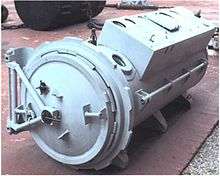 One person chamber
One person chamber Control panel of a basic deck decompression chamber
Control panel of a basic deck decompression chamber The medical lock of a basic deck decompression chamber with the door closed
The medical lock of a basic deck decompression chamber with the door closed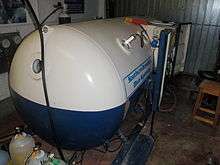 Exterior view of a basic deck decompression chamber
Exterior view of a basic deck decompression chamber Transportable decompression chamber
Transportable decompression chamber Divers breathing oxygen during surface decompression
Divers breathing oxygen during surface decompression Operating a chamber from the control panel
Operating a chamber from the control panel
Hyperbaric treatment chamber
Hyperbaric oxygen therapy chamber
A hyperbaric oxygen therapy chamber is used to treat patients, including divers, whose condition might improve through hyperbaric oxygen treatment. Some illnesses and injuries occur, and may linger, at the cellular or tissue level. In cases such as circulatory problems, non-healing wounds, and strokes, adequate oxygen cannot reach the damaged area and the body's healing ability is unable to function properly. Hyperbaric oxygen therapy increases oxygen transport via dissolved oxygen in serum, and is most efficacious where the haemoglobin is compromised (e.g. carbon monoxide poisoning) or where the extra oxygen in solution can diffuse through tissues past embolisms which are blocking the blood supply as in decompression illness.[2] Hyperbaric chambers capable of admitting more than one patient (multiplace) and an inside attendant have advantages for the treatment of decompression sickness (DCS) if the patient requires other treatment for serious complications or injury while in the chamber, but in most cases monoplace chambers can be successfully used for treating decompression sickness.[3] Rigid chambers are capable of greater depth of recompression than soft chambers which are unsuitable for treating DCS.
Recompression chamber
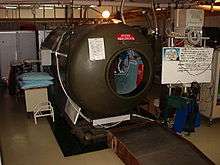
A recompression chamber is a hyperbaric treatment chamber used to treat divers suffering from certain diving disorders such as decompression sickness.[4]
Treatment is ordered by the treating physician (medical diving officer), and generally follows one of the standard hyperbaric treatment schedules such as the US Navy treatment Tables 5 or 6.[5]
When hyperbaric oxygen is used it is generally administered by built-in breathing systems (BIBS), which reduce contamination of the chamber gas by excessive oxygen.[6]
Test of pressure
If the diagnosis of decompression illness is considered questionable, the diving officer may order a test of pressure.[7] This typically consists of a recompression to 60 feet (18 m) for up to 20 minutes. If the diver notes significant improvement in symptoms, or the attendant can detect changes in a physical examination, a treatment table is followed.
Representative treatment tables
U.S. Navy Table 6 consists of compression to the depth of 60 feet (18 m) with the patient on oxygen. The diver is later decompressed to 30 feet (9.1 m) on oxygen, then slowly returned to surface pressure. This table typically takes 4 hours 45 minutes. It may be extended further. It is the most common treatment for type 2 decompression illness.
U.S. Navy Table 5 is similar to Table 6 above, but is shorter in duration. It may be used in divers with less severe complaints (type 1 decompression illness).
U.S. Navy Table 9 consists of compression to 45 feet (14 m) with the patient on oxygen, with later decompression to surface pressure. This table may be used by lower-pressure monoplace hyperbaric chambers, or as a follow-up treatment in multiplace chambers.
Saturation diving life support systems

DDC - Living chamber
DTC - Transfer chamber
PTC - Personnel transfer chamber (bell)
RC - Recompression chamber
SL - Supply lock

.jpg)
A hyperbaric environment on the surface comprising a set of linked pressure chambers is used in saturation diving to house divers under pressure for the duration of the project or several days to weeks, as appropriate. The occupants are decompressed to surface pressure only once, at the end of their tour of duty. This is usually done in a decompression chamber which is part of the saturation system. The risk of decompression sickness is significantly reduced by minimizing the number of decompressions, and by decompressing at a very conservative rate.
The saturation system typically comprises a complex made up of a living chamber, transfer chamber and submersible decompression chamber,[8] which is commonly referred to in commercial diving and military diving as the diving bell,[9] PTC (personnel transfer capsule) or SDC (submersible decompression chamber).[6] The system can be permanently installed on a ship or ocean platform, but is usually capable of being transferred between vessels. The system is managed from a control room, where depth, chamber atmosphere and other system parameters are monitored and controlled. The diving bell is used to transfer divers from the system to the work site. Typically, it is mated to the system utilizing a removable clamp and is separated from the system by a trunking space, through which the divers transfer to and from the bell.
The bell is fed via a large, multi-part umbilical that supplies breathing gas, electricity, communications and hot water. The bell also is fitted with exterior mounted breathing gas cylinders for emergency use. The divers operate from the bell using surface supplied umbilical diving equipment.
A hyperbaric lifeboat, hyperbaric escape module or rescue chamber may be provided for emergency evacuation of saturation divers from a saturation system.[8] This would be used if the platform is at immediate risk due to fire or sinking to get the occupants clear of the immediate danger. A hyperbaric lifeboat is self-contained and self-sufficient for several days at sea, and can be operated from the inside by the occupants while under pressure.
Transfer under pressure
The process of transferring personnel from one hyperbaric system to another is called transfer under pressure (TUP). This is used to transfer personnel from portable recompression chambers to multi-person chambers for treatment, and between saturation life support systems and personnel transfer capsules (closed bells) for transport to and from the worksite, and for evacuation of saturation divers to a hyperbaric lifeboat.
History
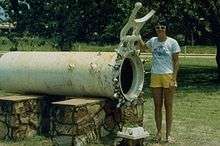
Experimental compression chambers have been used since about 1860.[10]
In 1904, submarine engineers Siebe and Gorman, together with physiologist Leonard Hill, designed a device to allow a diver to enter a closed chamber at depth, then have the chamber – still pressurised – raised and brought aboard a boat. The chamber pressure was then reduced gradually. This preventative measure allowed divers to safely work at greater depths for longer times without developing decompression sickness.[11]
In 1906, Hill and another English scientist M Greenwood subjected themselves to high pressure environments, in a pressure chamber built by Siebe and Gorman, to investigate the effects. Their conclusions were that an adult could safely endure seven atmospheres, provided that decompression was sufficiently gradual.[12]
A recompression chamber intended for treatment of divers with decompression sickness was built by CE Heinke and company in 1913, for delivery to Broome, Western Australia in 1914,[13] where it was successfully used to treat a diver in 1915.[14] That chamber is now in the Broome Historical Museum.[15]
Structure and layout
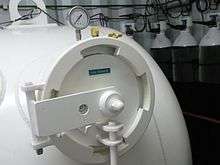
The construction and layout of a hyperbaric diving chamber depends on its intended use, but there are several features common to most chambers.
There will be a pressure vessel with a chamber pressurisation and depressurisation system, access arrangements, monitoring and control systems, viewports, and often a built in breathing system for supply of alternative breathing gases.[16]
The pressure vessel is the main structural component, and includes the shell of the main chamber, and if present, the shells of fore-chamber and medical or stores lock. A forechamber or entry lock may be present to provide personnel access to the main chamber while it is under pressure. A medical or stores lock may be present to provide access to the main chamber for small items while under pressure. The small volume allows quick and economical transfer of small items, as the gas lost has relatively small volume compared to the forechamber.[16]
An access door or hatch is normally hinged inward and held closed by the pressure differential, but it may also be dogged for a better seal at low pressure. There is a door or hatch at the access opening to the forechamber, the main chamber, both ends of a medical or stores lock, and at any trunking to connect multiple chambers. A closed bell has a similar hatch at the bottom for use underwater and may have a side hatch for transfer under pressure to a saturation system, or may use the bottom hatch for this purpose. The external door to the medical lock is unusual in that it opens outward and is not held closed by the internal pressure, so it needs a safety interlock system to make it impossible to open when the lock is pressurised.[16]
Viewports are generally provided to allow the operating personnel to visually monitor the occupants, and can be used for hand signalling as an auxiliary emergency communications method. Interior lighting can be provided by mounting lights outside the viewports.
Furniture is usually provided for the comfort of the occupants. Usually there are seats and/or bed facilities. Saturation systems also have tables and sanitary facilities for the occupants.
The internal pressure system includes a primary and reserve chamber gas supply, and the valves and piping to control it to pressurise and depressurise the main chamber and auxiliary compartments, and a pressure relief valve to prevent pressurisation beyond the design maximum working pressure. Valves are generally duplicated inside and outside and are labelled to avoid confusion. It is usually possible to operate a multiple occupant chamber from inside in an emergency. The monitoring equipment will vary depending on the purpose of the chamber, but will include pressure gauges for supply gas, and an accurately calibrated pressure gauge for the internal pressure of all human occupied compartments.[16]
There will also be a voice communications system between the operator and occupants. This is usually push to talk on the outside, and constantly transmitting from the inside, so that the operator can better monitor the condition of the occupants. There may also be a backup communications system.[16]
Firefighting equipment is necessary as a chamber fire is extremely dangerous to the occupants. Either fire extinguishers specially made for hyperbaric environment with non-toxic contents, or a pressurised internal water spray system can be used. Water buckets are often provided as additional equipment.[16]
Life support systems for saturation systems can be fairly complex, as the occupants must remain under pressure continuously for several day to weeks. Sanitation systems for washing and waste removal are required. Discharge is simple because of the pressure gradient, but must be controlled to avoid undesired chamber pressure loss or fluctuations. Chamber gas may be simply vented and flushed if it is air, but helium mixtures are expensive and over long periods very large volumes would be needed, so the chamber gas of a saturation system is recycled by passing it through a carbon dioxide scrubber and other filters to remove odours and excess moisture. Oxygen content of the chamber gas is constantly monitored and fresh oxygen added when necessary to maintain the nominal value. Catering is generally provided by preparing the food and drink outside and transferring it into the chamber through the stores lock, which is also used to transfer used utensils, laundry and other supplies.
Multiplace chambers which may be used for treatment usually contain a built-in breathing system (BIBS) for supply of breathing gas different from the pressurisation gas, and closed bells contain an analogous system to supply gas to the divers' umbilicals. Chambers with BIBS will generally have an oxygen monitor. BIBS are also used as an emergency breathing gas supply if the chamber gas is contaminated.[16]
Non-portable chambers are generally constructed from steel,[16] as it is inexpensive, strong and fire resistant. Portable chambers have been constructed from steel, aluminium alloy,[16] and fibre reinforced composites. In some cases the composite material structure is flexible when depressurised.[17][18]
Operation
Details will vary depending on the application. A generalised sequence for a stand-alone chamber is described. The operator of a commercial diving decompression chamber is generally called a Chamber operator, and the operator of a saturation system is called a life support technician (LST).
- Pre-use checks will be conducted on the system to ensure that it is safe to operate.
- The intended occupants will be checked and authorised for compression, and will enter the chamber.
- The pressure door will be closed, communications established with the occupants, and pressurisation started.
- The operator will monitor and control the rate of pressurisation and monitor the condition of the occupants.
- Once pressurised, the operator will monitor the pressure, the run time, the chamber gas and if applicable, the independent breathing gas supply. The chamber gas quality may be controlled by carbon dioxide scrubber systems, filters and air conditioner systems and addition of oxygen as required, or by periodic ventilation by adding fresh compressed air while simultaneously releasing some of the chamber air.
- When decompression is started, the operator will notify the occupants and release chamber gas to the atmosphere or to scavenge pumps if it to be recycled. The rate of pressure reduction is controlled to follow the specified decompression schedule within tolerance.
- Compression and decompression may be interrupted if the occupants experience problems caused by the pressure change, such as ear or sinus squeezes, or symptoms of decompression illness.
- When decompression is completed, chamber pressure is equalised with ambient pressure and the doors may be opened. Occupants may exit, and will usually be checked for absence of ill-effects.
- Chamber will receive post-operation service as required to be ready for next operation or storage as applicable.
Working pressure
A large range of working pressures are used, depending on the application of the chamber. Hyperbaric oxygen therapy is usually done at pressures not exceeding 18msw, or an absolute internal pressure of 2.8 bar. Decompression chambers are usually rated for depths similar to the depths that the divers will encounter during planned operations. Chambers using air as the chamber atmosphere are frequently rated to depths in the range of 50 to 90 msw, and chambers, closed bells and other components of saturation systems must be rated for at least the planned operational depth. The US Navy has Heliox saturation decompression schedules for depths up to 480 msw (1600 fsw).[6] Experimental chambers may be rated for deeper depths. An experimental dive has been done to 701 msw (2300 fsw), so at least one chamber has been rated to at least this depth.[19]
See also
- Glossary of underwater diving terminology
- Hyperbaric medicine
- Byford Dolphin (decompression accident)
- Diving bell
- Moon pool
- Saturation diving
- Surface supplied diving
- Decompression sickness
- Hyperbaric stretcher
References
- ↑ Zamboni, WA; Riseman, JA; Kucan, JO (1990). "Management of Fournier's Gangrene and the role of Hyperbaric Oxygen". Journal of Hyperbaric Medicine. 5 (3): 177–186. Retrieved 19 October 2014.
- ↑ US Navy (2006). "20". US Navy Diving Manual, 6th revision. United States: US Naval Sea Systems Command. Retrieved 2016-09-06.
- ↑ Kindwall, EP; Goldmann, RW; Thombs, PA (1988). "Use of the Monoplace vs. Multiplace Chamber in the Treatment of Diving Diseases.". Journal of Hyperbaric Medicine; 3(1). Undersea and Hyperbaric Medical Society, Inc. pp. 5–10. Retrieved 25 February 2016.
- ↑ "NOAA Ocean Explorer: Monitor Expedition 2002: decompression chamber". National Oceanic and Atmospheric Administration. 2002. Retrieved 3 July 2010.
- ↑ http://www.supsalv.org/00c3_publications.asp
- 1 2 3 US Navy Diving Manual, 6th revision. United States: US Naval Sea Systems Command. 2006. Retrieved 2008-04-24.
- ↑ Rudge, FW; Stone, JA (March 1991). "The use of the pressure cuff test in the diagnosis of decompression sickness.". Aviat Space Environ Med. pp. 266–7. PMID 2012577. Retrieved 6 September 2016.
- 1 2 Lettnin, Heinz (1999). International textbook of Mixed Gas Diving. Flagstaff, AZ: Best Publishing. ISBN 0941332500.
- ↑ Bevan, J. (1999). "Diving bells through the centuries". South Pacific Underwater Medicine Society Journal. 29 (1). ISSN 0813-1988. OCLC 16986801. Retrieved 2008-04-25.
- ↑ Hyperbaric chamber, Encyclopaedia Britannica, retrieved 2 March 2015
- ↑ "Ocean Treasure". The Daily News. Perth, Western Australia. 25 July 1904. p. 6. Retrieved 2 March 2015.
- ↑ "The Dangers to Divers. Scientists' pressure test". The World's News. 2 June 1906. p. 21. Retrieved 2 March 2015.
- ↑ "untitled". Sunday Times. Sunday Times, Perth, WA. 1 March 1914. p. 23. Retrieved 2 March 2015.
- ↑ "Divers' paralysis. Interesting case at Broome. Success of the recompression method". The West Australian. 15 March 1915. p. 8. Retrieved 2 March 2015.
- ↑ Jones, Natalie (1 March 2015). "Pearling industry marks 100 years of treating the bends". Australian Broadcasting Corporation. Retrieved 2 March 2015.
- 1 2 3 4 5 6 7 8 9 US Navy (2006). "21". US Navy Diving Manual, 6th revision. United States: US Naval Sea Systems Command. Retrieved 2016-09-06.
- ↑ Staff (2005). "Emergency Evacuation Hyperbaric Stretcher System". PCCI, Inc. Retrieved 12 September 2016.
- ↑ Latson, G.W.; Flynn, ET (1999). "Use of Emergency Evacuation Hyperbaric Stretcher (EEHS) in Submarine Escape and Rescue.". Technical Report No 4-99. Navy Experimental Diving Unit. Retrieved 12 September 2016.
- ↑ staff (1992-11-28). "Technology: Dry run for deepest dive" (1849). NewScientist. Retrieved 2009-02-22.
External links
| Wikimedia Commons has media related to Decompression chambers. |
- "Divers Go to Greater Depths With Aid of Chamber" Popular Mechanics, December 1930 first use of diving chamber by British Royal Navy divers—detail drawings on subject
- Decompression Chamber in detail
- The short film Hyperbaric Chamber (1979) is available for free download at the Internet Archive

